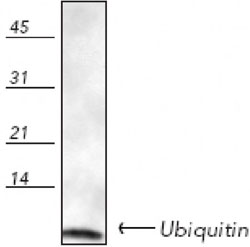662099 Sigma-AldrichAnti-Ubiquitin Rabbit pAb
This Anti-Ubiquitin Rabbit pAb is validated for use in Immunoblotting, Immunohistochemistry, Immunoprecipitation for the detection of Ubiquitin.
More>> This Anti-Ubiquitin Rabbit pAb is validated for use in Immunoblotting, Immunohistochemistry, Immunoprecipitation for the detection of Ubiquitin. Less<<Recommended Products
개요
| Replacement Information |
|---|
주요 사양표
| Species Reactivity | Host | Antibody Type |
|---|---|---|
| B, Ca, Ch, Dr, E. coli, Fg, Gp, Ht, H, Mk, M, Rb, R, Sh, Yeast | Rb | Polyclonal Antibody |
가격 및 재고여부
| 카탈로그 번호 | 재고 정보 | 패킹 | 포장 단위 | 가격(VAT 별도) | 수량 | |
|---|---|---|---|---|---|---|
| 662099-50ULCN |
|
Plastic ampoule | 50 ul |
|
— |
| Product Information | |
|---|---|
| Form | Liquid |
| Preservative | ≤0.1% sodium azide |
| Quality Level | MQ100 |
| Physicochemical Information |
|---|
| Dimensions |
|---|
| Materials Information |
|---|
| Toxicological Information |
|---|
| Safety Information according to GHS |
|---|
| Safety Information |
|---|
| Product Usage Statements |
|---|
| Packaging Information |
|---|
| Transport Information |
|---|
| Supplemental Information |
|---|
| Specifications |
|---|
| Global Trade Item Number | |
|---|---|
| 카탈로그 번호 | GTIN |
| 662099-50ULCN | 04055977261189 |
Documentation
Anti-Ubiquitin Rabbit pAb MSDS
| 타이틀 |
|---|
Anti-Ubiquitin Rabbit pAb Certificates of Analysis
| Title | Lot Number |
|---|---|
| 662099 |
References
| 참고문헌 보기 |
|---|
| Jungmann, J., et al. 1993. Nature 361, 369. Hershko, A., and Ceichanover, A. 1992. Annu. Rev. Biochem. 61, 761. Hochstrasser, M. 1992. Curr. Opin. Cell Biol. 4, 1024. Jentsch, S. 1992. Annu. Rev. Genet. 26, 179. Hershko, A., et al. 1982. J. Biol. Chem. 257, 13964. |
Brochure
| Title |
|---|
| Caspases and other Apoptosis Related Tools Brochure |








